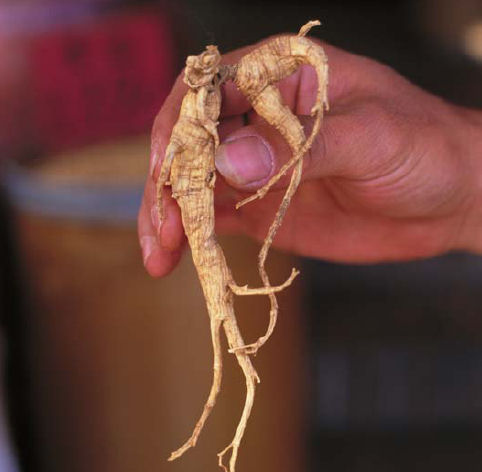|
 |
| |
|
Korean and Siberian
Ginseng |
What is it?
A lot of confusion arises between the
different types of ginsengs.
The botanical name of siberian ginseng is
eleutherococcus senticosus and it belongs to
the Araliaceae family.
The part of Siberian ginseng that is used
medicinally is the root, with triterpenoid
saponins (eleutherosides) being the main
active constituent. It has a stimulating
adaptogen action on the body, increases the
bodys resistance to stress and builds up
general vitality.
The botanical name of Korean ginseng is
panax ginseng and it belongs to the
Araliaceae family.
|
 |
The part of Korean ginseng that is used
medicinally is the root, with triterpenoid
saponins (ginsenosides) being the main
active constituent. It also has a
stimulating adaptogen action on the body. It
has been traditionally used in Chinese
medicine for thousands of years as a
stimulant and tonic. The Chinese use it
either short-term to improve stamina,
concentration and stress resistance or
long-term for wellbeing, the elderly or
debilitating conditions. It is traditionally
used to treat cold syndromes such as weak
pulse and exhaustion.
Why you may need Korean and Siberian
ginseng
Siberian
Stress resistance in Russia studies found
that healthy volunteers adapted well to
increased stress in a work setting such as
increased physical labour, noise and high
temperature by showing an increase in mental
alertness and work efficiency.
Recurrent infections studies reported on
increase in white blood cells while taking
Siberian ginseng.
Korean
Exhaustion and stress ginseng supports the
adrenals during stress both short and long
term.
Memory studies indicate that ginseng
improved memory, mental performance and
reaction time.
High cholesterol while taking Korean
ginseng, improvements in serum total
cholesterol, HDL cholesterol, triglycerides
were noted in patients with high
cholesterol.
Diabetes ginseng reduces blood sugar
levels in diabetic and non-diabetic
patients.
Fertility in men ginseng increases sperm
production men.
Menopause the slight oestrogenic effect of
ginseng is shown to reduce menopausal
symptoms in women.
Post surgery or illness ginseng aids
recovery, is a tonic and improves resistance
to infection.
How much to use?
Siberian ginseng
600 mg 3 g dry root daily for up to one
month.
Korean ginseng
Short-term for young healthy people: 250500
mg root two times a day for up to three
weeks.
Long-term for elderly or those with
debilitating conditions: 400 mg 8 g root
daily.
Safety notes
Both ginsengs are generally well tolerated.
Side effects that have been reported include
insomnia, palpitations, hypertension,
hypotension, irritability, diarrhoea,
menstrual changes and headache. If you have
diabetes, hypertension, a bleeding disorder,
anxiety, insomnia, hormonal condition,
cardiovascular disease or generally have a
nervous disposition, consult your healthcare
professional before supplementing with
either ginseng.
Korean and Siberian ginseng are not
recommended during pregnancy or while
breastfeeding.
ETHIS INFORMATION IS NOT INTENDED TO TREAT
OR DIAGNOSE. ALWAYS CONSULT YOUR HEALTHCARE
PROFESSIONAL BEFORE TAKING NUTRITIONAL OR
HERBAL SUPLIMENTS
Source:http:// www.govita.com.au/Library/Herb/GinsengHerb
|
|
|
|
|
|
|
|
|
|
Go Vita Smithfield
Shop 151 / Smithfield Shopping Centre, SMITHFIELD QLD 4878
P 07 4038 1662 |
www.govita.com.au
Go Vita Earlville
Shop 104 Stockland Earlville, Mulgrave Road, EARLVILLE QLD 4870
P 07 4054 2481 |
www.govita.com.au
|
|